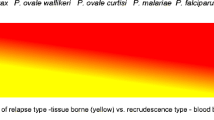Abstract
For a long time, only two phases of the life cycle of the agents of malaria parasites were known: the cycle inside the mosquito body and the cycle in the red blood cells of humans as intermediate hosts. A possible tissue development cycle inside humans, however, had already been proposed before 1900. In general, Pieter Klaesz Pel is considered the first scientist who has described such a tissue cycle. However, a closer look at Pel’s work shows that he still followed an old (conservative) way of thinking, since he still referred to “malaria poison and malaria miasma.” Thus, the first idea of a possible tissue cycle must be searched in the work of earlier scientists. Referring to their observations on malaria, Vassilij Danilevsky, Arman Ruffer, Camillo Golgi and Battista Grassi suspected developing parasites in internal organs, before they can be found in the bloodstream.
Similar content being viewed by others
References
Cogswell FB (1992) The hypnozoite and relapse in primate malaria. Clin Microbiol Rev 5(1):26–35
Collins EW (2007) Further understanding the nature of relapse of Plasmodium vivax infection. J Infect Dis 195:919–920
Danilevsky VY (1891) A l étude de la microbiose malarique. Ann Inst Pasteur 12:758–783
Franken G (2016) Gibt es Malaria-Rückfälle durch das Plasmodium ovale? Eine kritische Literaturanalyse, Dissertation Düsseldorf
Golgi C (1893) Sulle febbri malariche estive-autunnali die Roma. Lettera al Prof. Guido Baccelli. Gazzetta Medica di Pavia 2:481-493, 505-520, 529-544, 553-559
Golgi C (1894a) Sur les fièvres malariques estivo-automnales de Rome. Arch Ital Biol 20:288–402
Golgi C (1894b) Ueber die römischen Sommer-Herbst Malariafieber. Dtsch Med Wochenschr 20(13/ 14):291–292, 317-318
Golgi C (ed) (1929) Gli studi di Camillo Golgi sulla malaria, raccolti e ordinati dal Prof. Aldo Perroncito, Roma
Grassi B (1900) Studi di uno zoologo sulla malaria. Roma
Grassi B (1901) Die Malaria. Studien eines Zoologen. 2. Aufl. Jena
Hirsch A ed. (1962) Biographisches Lexikon der hervorragenden Ärzte aller Zeiten und Völker. Urban & Schwarzenberg München, 3. Auflage
Kikuth W, Mudrow L (1941) Die endotheliale Phase der Malariaparasiten und ihre theoretische und praktische Bedeutung. Ergeb Hyg Bakteriol Immunitätsforsch Exp Ther 24:1–86
Krotoski WA, Krotoski DM, Garnham PCC, Bray RS, Killick-Kendrick R, Draper CC (1980) Relapses in primate malaria: discovery of two populations of exoerythrocytic stages. Preliminary note. BMJ 280(6208):153–154
Krotoski WA, Bray RS, Garnham PCC, Gwadz RW, Killick-Kendrick R, Draper CC (1982) Observations on early and late post-sporozoite tissue stages in primate malaria. II. The hypnozoite of Plasmodium cynomolgi bastianellii from 3 to 105 days after infection, and detection of 36- to 40-hour pre-erythrocytic forms. Am J Trop Med Hyg 31(2):211–225
Laveran C (1880) Un noveau parasite. Trouvé dans le sang des malades atteints de fièvre palustre. Bulletins de la Société Médicale des Hopitaux de Paris 158–164
Mehlhorn H, Markus MB (1976) Electron microscopy of stages of Isospora felis of the cat in the mesenteric lymph node of the mouse. Z Parasitenkd 51(1):15–24
Meis JFGM, Verhave JP (1988) Exoerythrocytic development of malarial parasites. Adv Parasitol 27:1–61
Pel PK (1886) Mededdeelingen uit de Geneeskundige kliniek. Malaria infectie. Ned Tijdschr Geneeskd 22:341–358
Pel PK (1887) Pseudoleukaemie oder chronisches Rückfallsfieber? Berl Klin Wochenschr 24:644–646
Ruffer MA (1893) Recent researches on protozoa and disease. The Second Hunterian Lecture delivered before the Hunterian Society. BMJ 2(1711):825–829
Thayer WS (1897) Lectures on the malarial fevers. D. Appleton and Company, New York
Van Gijn J, Gijselhart J (2009) Professor Pel en ‘klierkoorts’. Ned Tijdschr Geneeskd 153:A1215
von Pettenkofer M (1869) Boden und Grundwasser in ihren Beziehungen zu Cholera und Typhus. Erwiederung auf Rudolf Virchow’s hygienische Studie: “Canalisation oder Abfuhr?”. Z Biol 5(2):171–310
White NJ (2011) Determinants of relapse periodicity in Plasmodium vivax malaria. Malar J 10(297):1–35
Acknowledgments
This work is part of a medical thesis by Gabriele Franken (Franken 2016).
Author information
Authors and Affiliations
Corresponding author
Rights and permissions
About this article
Cite this article
Franken, G., Bruijns-Pötschke, M., Richter, J. et al. Malaria relapses were already known before 1900—a discussion. Parasitol Res 116, 185–189 (2017). https://doi.org/10.1007/s00436-016-5275-z
Received:
Accepted:
Published:
Issue Date:
DOI: https://doi.org/10.1007/s00436-016-5275-z




